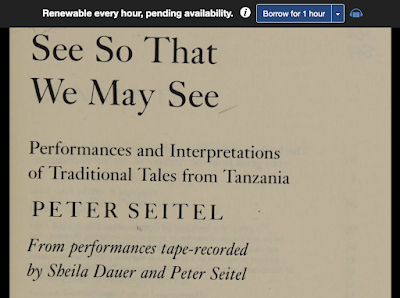The book contains 35 stories told by Haya storytellers in Tanzania; you can read more about the Haya people at Wikipedia.
The book also provides an overview of Haya traditions and culture in the introduction. As Seitel explains in the preface to the book, "When a Haya audience says to a Haya narrator, 'See so that we may see,' they are agreeing to participate in the telling of a tale." Hence the title of the book.
Here are links to the specific stories: Give-him-sweetness-if-he-cries /
The Water of Ikongora /
Lusimbagila Bestows on All /
I Shall Be Drinking From Them /
Open and Let Them Come in /
Nchume /
Three Brothers /
Child of the Valley /
Teaser /
Little Leper of Munjolobo /
The Serpent of Kamushalanga /
Squeezer /
Mutele, You've Left Me, You've Gove /
The Legend of Idimba /
The Bride's Relish /
Kyusi, Kyusi, Good Dog! /
I Ate Minnows, Little Minnows /
Woman-of-people-forbidden-horn /
It Was Haste That Killed Her /
Have You Not Seen Lubundu? /
Blocking the Wind /
Crested Crane and Dove /
Kibwana /
The Woman "Full Moons" /
Kulili Your Brother of Only One Mother /
Satisfaction /
She's Killed One; We've All of Us Come /
The Glistening One /
The Strong One /
Salute Leopard, Who's Living in the Past /
Magezi /
Greens of the Cow Pasture /
Look Back and See What Lugeye Does! /
Who Was the One Who Ate It? /
What Was It That Killed Koro?
Peter Seitel worked at the Smithsonian Center for Folklife and Cultural Heritage as senior folklorist and then director of the center, and he was also its webmaster. He created software called Synchrotext to enable annotations to media files; the stories in this book were based on recordings made in Tanzania in the 1970s. Unfortunately, I have not been able to find the archive of recordings that he published on the Internet; perhaps they will resurface at a later date. He completed the recordings with help from Sheila Dauer, who went on to work for Amnesty International USA and who is now teaching at NYU.
The Internet Archive also has this volume of proceedings from a 1999 conference that Seitel helped organize as a joint effort of UNESCO and the Smithsonian: Safeguarding Traditional Cultures: A Global Assessment.
So, you can learn about Seitel's professional work there in defense of traditional cultures and folkways, and you can also enjoy the wonderful stories from Tanzania that he share with the world in See So That We Can See, all just a click away at the Internet Archive.




No comments:
Post a Comment
Comments are limited to Google accounts. You can also email me at laurakgibbs@gmail.com or find me at Twitter, @OnlineCrsLady.